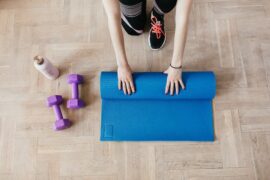What are you seeking to have more control over your fitness journey? Are you ready to create your own exercise routine and take charge of your health? If that is the case, you have come to the right place. In this blog post, we’ll talk about how designing a personalized fitness routine can improve your outcomes and make it easier for you to achieve your health objectives. Prepare to discover how even minor adjustments to your fitness routine will quickly get you moving!
Choosing The Right Exercise Types For Your Goals
Choosing the right types of exercise for your personal goals is crucial in creating an effective fitness routine. Knowing what exercise affects which part of your body is essential in designing a safe and successful exercise program. For example, the muscles worked during front squats are different from those worked during barbell rows. Knowing the differences between exercises and how they target different muscles is key to making sure your routine will have the desired effect.
Cardiovascular Conditioning
Incorporating cardiovascular conditioning into your routine is a crucial element for overall fitness. This form of exercise, often referred to as cardio, includes activities like running, swimming, or cycling, which increase heart rate and improve the body’s oxygen utilization. Determining the right type, intensity, and duration of cardio activities for your personal fitness goals and current fitness level is essential. If you’re a beginner, starting with lower-intensity exercises like brisk walking or light jogging might be more suitable. As your fitness level improves, gradually increasing the intensity of your cardio workouts can help maximize results. Remember, the key is consistency and listening to your body to find your rhythm in cardiovascular conditioning.
Building Strength
Resistance training serves as the backbone of a strength-building regimen. It entails activities that require your muscles to exert force or weight against them. This type of training can include lifting weights, using resistance bands, or bodyweight exercises such as push-ups and pull-ups. Regular resistance training can help build muscle mass, increase metabolism, and improve bone density.
However, strength-building is not limited to resistance training alone. Incorporating functional exercises that mimic everyday movements can enhance your strength and agility, making daily tasks easier. These exercises often use multiple muscle groups at once, promoting balance and coordination.
Also, it’s essential to remember that adequate recovery is an integral component of a strength-building routine. This includes getting appropriate rest between workouts and ensuring a nutritious diet to support muscle growth and repair. Just like with cardiovascular conditioning, finding the right balance between intensity and rest is crucial for long-term success in building strength.

Flexibility And Balance
Flexibility and balance are pivotal components of a comprehensive fitness routine, often undervalued but critical for overall health and well-being. Incorporating functional exercises into your regimen can effectively enhance these components. Functional exercises, such as yoga or Pilates, focus on improving body mobility, flexibility, and balance by simulating common movements you might do at home, at work, or in various sports.
Exercises like lunges, squats, push-ups, or single-leg stands are great examples of functional training that not only strengthens your muscles but also promotes better body alignment and coordination. These exercises often engage multiple muscle groups simultaneously, developing more balanced muscle strength and joint stability and enhancing your ability to perform daily activities with ease.
In addition to improving muscle strength and balance, functional exercises often incorporate stretching elements, which help increase your range of motion and flexibility. This increased flexibility can reduce the risk of injury, improve posture, and even contribute to better athletic performance.
Creating A Realistic And Sustainable Schedule
Creating a realistic and sustainable schedule is a cornerstone in developing a customized fitness routine. This involves setting achievable goals, allocating time for workouts, and allowing room for flexibility. Start by identifying the days and times you are most likely to stick to your routine. If you’re an early bird, morning workouts could be your best bet. If you’re a night owl, consider exercising in the evenings.
Set clear, achievable goals for your workouts. If you’re just starting, it might be more realistic to set a goal of working out two or three times a week, rather than every day. As your fitness level improves, you can progressively increase the frequency and duration of your workouts.
Ensure that your schedule is flexible enough to accommodate unforeseen circumstances. There will be days when you have to miss a workout due to an unexpected commitment or when you’re simply not feeling up to it. Don’t let these minor setbacks derail your entire fitness routine. Instead, adjust your schedule as needed and get back on track as soon as possible.
In conclusion, designing an effective and customized fitness routine requires careful planning, a clear goal in mind, and consistency. This includes selecting the right exercises for your goals, setting realistic expectations, and being flexible when life gets in the way. With dedication and determination, you’ll be on your way to achieving maximum results with ease!


































